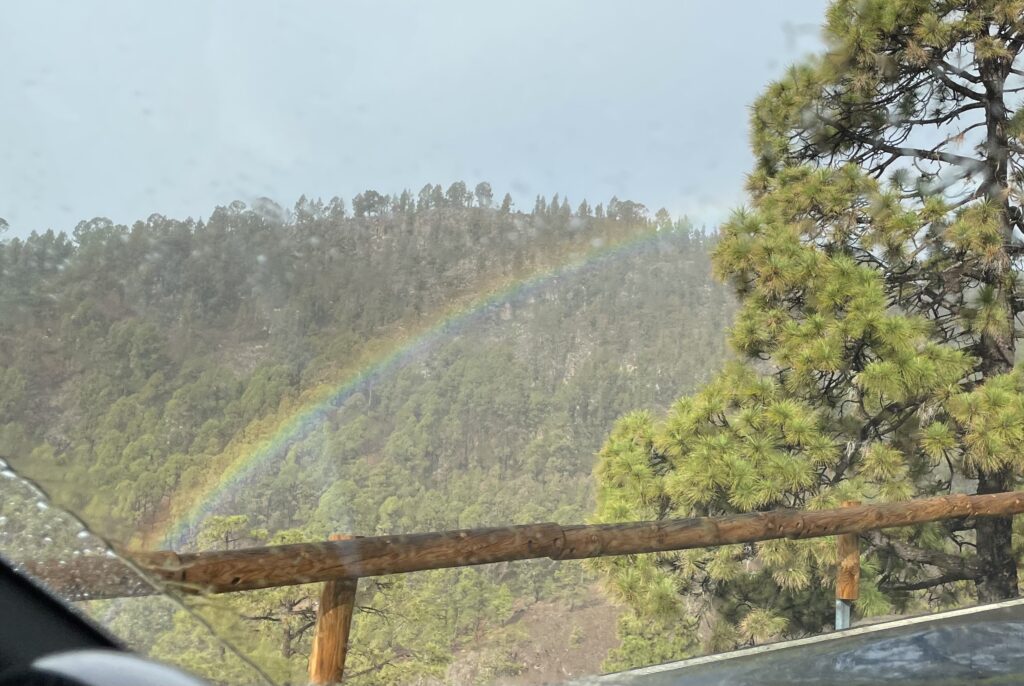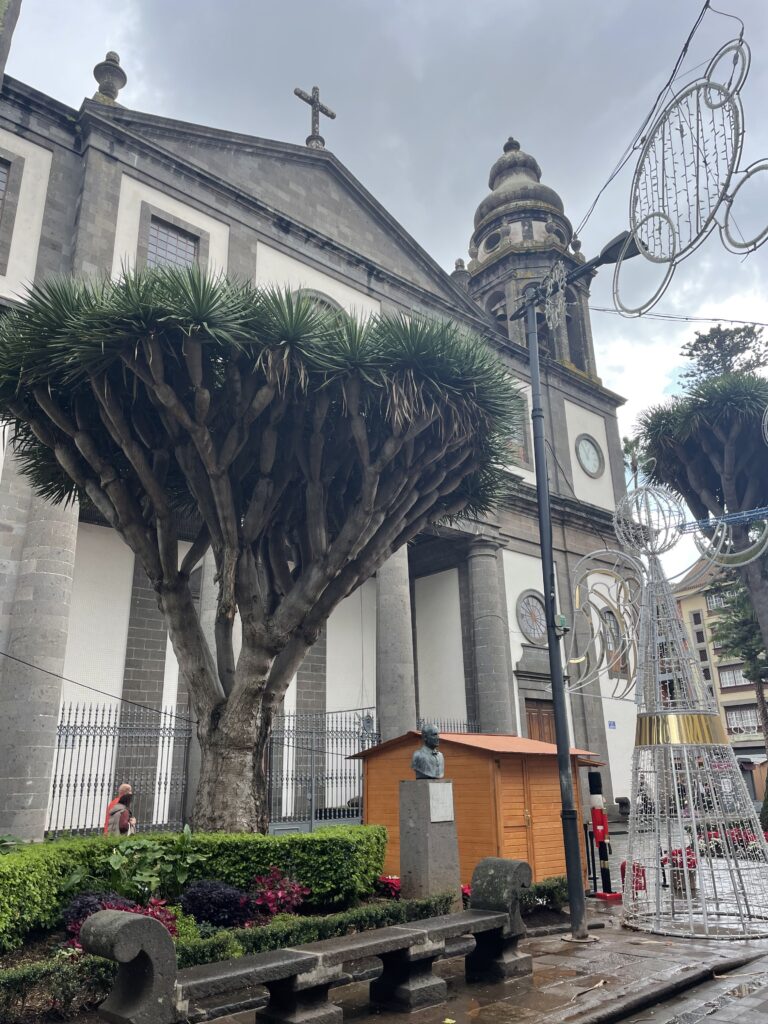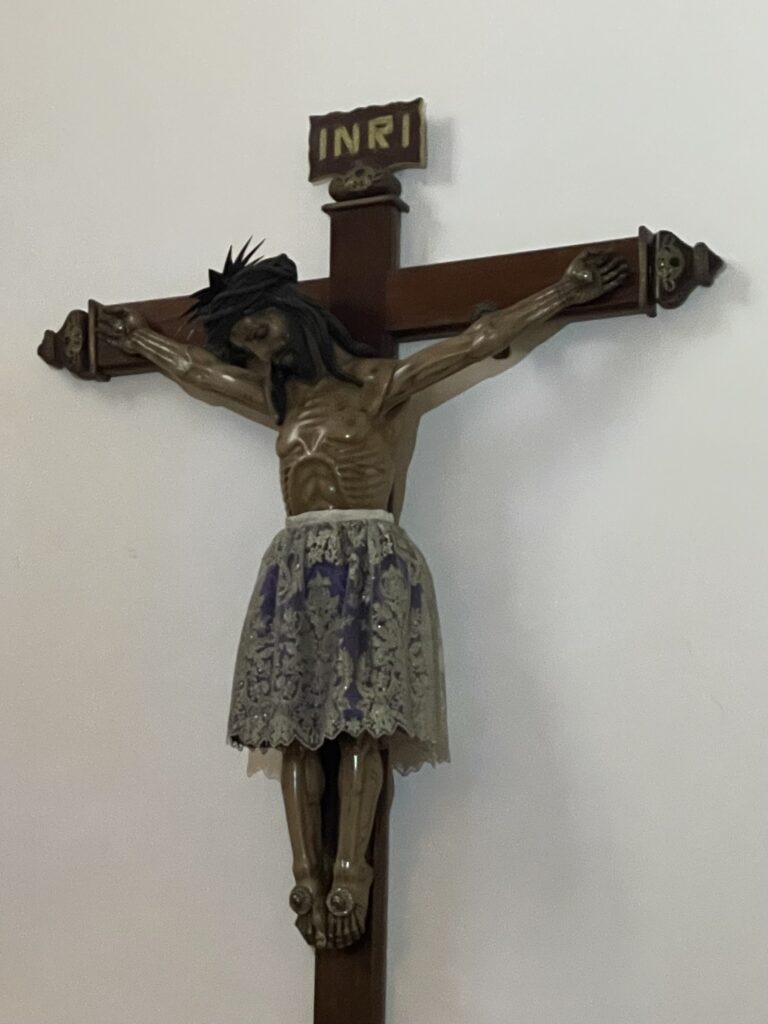In which Sid and Doris visit less of Tenerife than they had hoped.  From Vilaflor the climb continues through and above the rainbows as we aim for Tenerife’s ridge road along the still-active volcano. This is made all the more exciting when a motorhome coming the other way is covered in snow (which is better than lava). Twenty minutes later the road is closed, showing that all the traffic that had been coming down was actually thwarted traffic originally going up, so it is 180 degrees for us too.
From Vilaflor the climb continues through and above the rainbows as we aim for Tenerife’s ridge road along the still-active volcano. This is made all the more exciting when a motorhome coming the other way is covered in snow (which is better than lava). Twenty minutes later the road is closed, showing that all the traffic that had been coming down was actually thwarted traffic originally going up, so it is 180 degrees for us too.
Back through Vilaflor and down into Granadilla, and so far the “twisty” roads promised in the description have been 45km of non-stop twisty, making our arms ache at the thought of our veteran-car-driving friends trying to get round all the bends. Looking for another route north, the old road, the TF28 which looks fantastic on the map and is highlighted with Mr Michelin’s special Green Line for Scenic Roads, was forecast to take another 2h30m to do 80km. An average speed of 20mph speaks for itself, so we guiltily hopped on the coastal motorway which wafted us to La Laguna in rather under an hour. La Laguna is now called Laguna Humeda as a set of short sharp showers come through.
A visit to the museum of History and Anthropology gives Sid some background information:
There is some rain, but not much now. The islands seem to have been inhabited since 3000 BCE. When the Berbers came from Morocco in about 200 CE they brought barley, durum wheat, lentils, beans, peas and figs. Over time, archeaobotanists say that this variety diminished. The islands are volcanic so there is no coal or iron. The economy has been based on agriculture and then tourist farming.
Trees were felled for fuel and in the 1500s to make way for sugar plantations with attendant slaves. The sugar trade died once America and the Caribbean were colonised and cheap sugar flooded the world (so long as you ignore what economists coyly call ‘the externalities’).
Fortunately the volcanic soil and temperate climate could support grapes instead. Canarian wine was sold into England by the monopoly holding Canary Islands’ Company and all went well until in the 1680s when locusts with a taste for grapes came. That and the War of the Spanish Succession put an end to that. And the islands were destitute.
Next crop introduced here in the 1820s: carmine from cochineal, a dye from squashed insects fed on prickly pear. This industry collapsed in the 1870s, (Sid, find out why!) So next up is the Canarian banana, commercialised by the French Consul on the island in 1855. Peak exports came in 1913 but other geopolitical events ruined that trade too.
Probably the next economic lifeline was emigration and remittances. And now tourism, so here are Sid and Doris spoiled for choice in the matter of hotels, bodegas, car hire companies and persons mysteriously offering camel rides. The Silk Road?
 Enough of Sid’s digression into the economic history. Doris is having a bout of navigator’s twitch, but as the ferry is minutes away the twitch is calmed with a cathedral visit. Though St. Mary of the Cures was finished in 1915 it looks more like a South American church from the 1700s.
Enough of Sid’s digression into the economic history. Doris is having a bout of navigator’s twitch, but as the ferry is minutes away the twitch is calmed with a cathedral visit. Though St. Mary of the Cures was finished in 1915 it looks more like a South American church from the 1700s.
Inside Jesus is wearing a neatly-sewn skirt on the cross while Mary and other saints are elaborately costumed. The town museum is also quite calming. Whatever we see will be agreed to be very interesting, though nothing of much global import has ever happened here. It’s a frame of mind.
Eschewing the perfectly innocent cafes lining the streets, Doris heads determinedly ferry-wards.
P.S. The end of the Canaries cochineal trade: Sid finds that the early cochineal trade was controlled by Spain. Until Leeuwenhhok looked at cochineal dye under a microscope in 1704 people outside the trade did not know the dye was crushed insect, though it is hard to believe the trade secret survived so long. Even so, the Spanish maintained control of the trade until South American countries’ independence in the early 1800s whereafter anyone with a prickly pear could go into competition. The Dutch reduced cochineal industry labour costs by setting up in Java (with a gardener bribed away from Cadiz in 1828) and enslaving the locals. Cochineal production expanded but was rendered obsolete with the 1856 introduction of William Henry Perkin’s synthetic dyes. Everything is interesting, if you are interested.
P.P.S. Score against the keywords: Teide 0%, Twisty roads and Hispanic towns in the North 100%. Teide which is allegedly “visible from everywhere in the island” is either hidden behind lower shoulders or shrouded in cloud. For invisible mountain summits, see also Sid and Doris’ cycle trip to Chinese Everest Base Camp in 2008, which might make its way into the historical section of this blog at some point.

Everything is interesting, if you are interested. Words of wisdom…